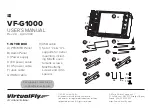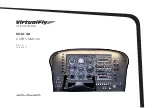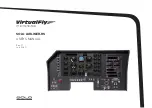
99
190-00607-02 Rev C
Detailed Operation
Radar
unless another cell or a ground target can be seen
beyond the heavy cell.
radar Signal reflectivity
Precipitation
Precipitation or objects more dense than water,
such as earth or solid structures, will be detected by
the weather radar. The weather radar will not detect
clouds, thunderstorms or turbulence directly. It detects
precipitation associated with clouds, thunderstorms,
and turbulence. The best radar signal reflectors are
raindrops, wet snow or wet hail. The larger the rain-
drop the better it reflects. The size of the precipitation
droplet is the most important factor in radar reflectiv-
ity. Because large drops in a small concentrated area
are characteristic of a severe thunderstorm, the radar
displays the storm as a strong return. Ice, dry snow,
and dry hail have low reflective levels and often will
not be displayed by the radar. A cloud that contains
only small raindrops, such as fog or drizzle, will not
reflect enough radar energy to produce a measurable
target return.
Precipitation Type and Reflectivity
Ground Returns
The intensity of ground target returns depends
upon the angle at which the radar beam strikes the
ground target (Angle of Incidence) and the reflective
properties of that target. The gain can be adjusted so
shorelines, rivers, lakes, and cities are well defined.
Increasing gain too much causes the display to fill in
between targets, thus obscuring some landmarks.
Cities normally provide a strong return signal.
While large buildings and structures provide good
returns, small buildings can be shadowed from the
radar beam by the taller buildings. As the aircraft
approaches, and shorter ranges are selected, details
become more noticeable as the highly reflective regular
lines and edges of the city become more defined.
Bodies of water such as lakes, rivers, and oceans
are not good reflectors, and normally do not provide
good returns. The energy is reflected in a forward scat-
ter angle with inadequate energy being returned. They
can appear as dark areas on the display. However,
rough or choppy water is a better reflector and will
provide stronger returns from the downwind sides of
the waves.
Mountains also provide strong return signals to the
antenna, but also block the areas behind. However,
over mountainous terrain, the radar beam can be
reflected back and forth in the mountain passes or off
canyon walls using up all or most of the radar energy.
In this case, no return signal is received from
this area causing the display to show a dark spot
which could indicate a pass where no pass exists.






































